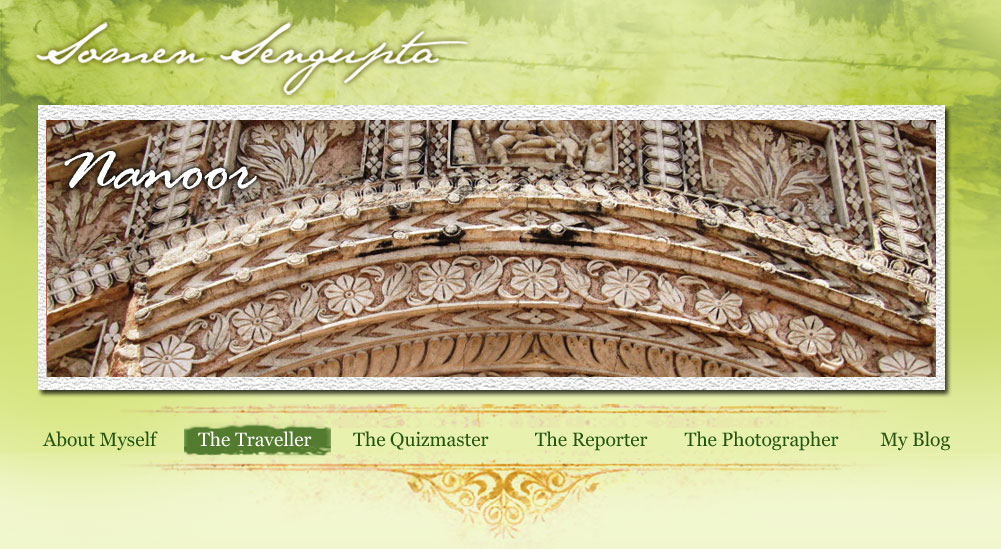|
Digging Facts : Excavation of Basuli statue & temple artifacts have led to the belief that poet Dwijo Chandidas lived at Nanoor in Birbhum District of Bengal.
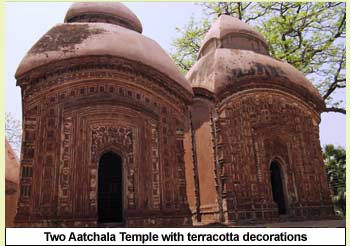 The excavation of Nanoor temple complex brought to light a rich history of Bengal and artifacts that was hitherto lost to the civilization. Nanoor temple complex of the Birbhum district of Bengal which is 18km from Bolpur, is a place where legend and history co-exist. The excavation of Nanoor temple complex brought to light a rich history of Bengal and artifacts that was hitherto lost to the civilization. Nanoor temple complex of the Birbhum district of Bengal which is 18km from Bolpur, is a place where legend and history co-exist.
Nanoor is that small place where medieval humanist poet Dwijo Chandidas lived and spread his noble message through his verses.This was the time when Vajrajana school of Buddhism begun to flourish. At the same time Hindu god & goddess entered the Buddhist pantheon in this part of Bengal. Hindu goddess Saraswati entered Buddhist mythology as Vajreshwari Devi and later was reincarnated as Hindu goddess Basuli.
It is believed that Dwijo Chandidas was worshipper of Basuli and a temple dedicated to the goddess was built at Nanoor. According to history Dwijo Chandidas was brutally killed in Kirnahar village in the broad day light when he was singing his verse in a kirtan akhra. It is believed that soldiers of muslim rulers Pathan Khilji killed him and reduced the Basuli temple to rubble. A priceless Radha Krishna image along with many more artifacts were destroyed.
In the next 300 years there was no evidence of the temple. In early 18th century local people excavated a mound at Nanoor and the Basuli image as described by Dwijo Chandidas was found from there.
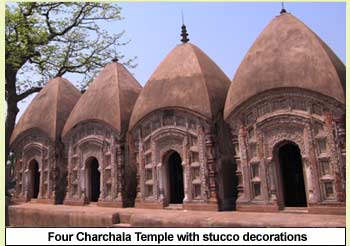 Moved by this amazing discovery zamindar of Dheka village Ramjeevan Roy built a new temple of Basuli in the memory of Dwijo Chandidas. Along with the main temple,14 additionally beautifully designed temples were built over the years. Thus with a set of 15 temples, a new temple complex was gradually formed. Today whatever we see at the temple complex is similar to the kind we had at that place in 17th and 18th century. Moved by this amazing discovery zamindar of Dheka village Ramjeevan Roy built a new temple of Basuli in the memory of Dwijo Chandidas. Along with the main temple,14 additionally beautifully designed temples were built over the years. Thus with a set of 15 temples, a new temple complex was gradually formed. Today whatever we see at the temple complex is similar to the kind we had at that place in 17th and 18th century.
It is unfortunate that large scale excavation was never undertaken in Nanoor.The first phase of excavation was conducted in 1945-46 by University of Calcutta while Archaeological Survey of India executed another phase of excavation in 1963-1964 .Both the excavation concluded that the place was inhabited from ancient period but none of the report concluded very strongly that poet Dwijo Chandidas lived here. However the discovery of the Basuli statue and the discovery of the several temples led to the belief that it was indeed the place where Dwijo Chandidas was once lived and worked.
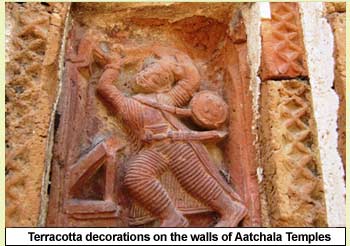 The temple complex of Nanoor having 15 temples is divided into three groups. One group of temples have plain roof while others are aatchala or charchala temples which is very common in Bengal school of temple architecture. The aatchala temples have eight slops roof and are embellished with terracotta motifs. The charchala temples are richly decorated with stucco. The seven brick temples are bare. Simple and one have Durga dalan. The temple complex of Nanoor having 15 temples is divided into three groups. One group of temples have plain roof while others are aatchala or charchala temples which is very common in Bengal school of temple architecture. The aatchala temples have eight slops roof and are embellished with terracotta motifs. The charchala temples are richly decorated with stucco. The seven brick temples are bare. Simple and one have Durga dalan.
Two temples with terracotta tiles are larger in shape and they stand on the common plinth.Both temples have plethora of floral motifs in their central panel while borders are richly decorated with human figures – mainly that of Dashavatar of Vishnu .The top row of the central space of the entry gate is decorated with small human figures paying various musical instruments while the panel just above the gate in central arch contains a row of small chariots which is a common design in terracotta temples.
One of the temple has Mahishashur Mardini in the centre which Laxmi, Ganesh,Saraswati & Kartik on her two sides. The figures are small in size but good enough to impress.The most common subject that is found on these temples is Krishna leela and Purana.A panel showing Krishna eating butter is beautiful.
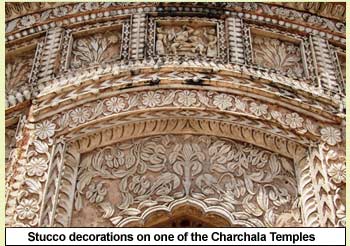 It is not terracotta but the magic of stucco that makes the temple complex of Nanoor exceptional in Bengal's landscape.Nanoor's temple walls are richly decorated with stucco – a mixture lime,sand and dust shell. It is not terracotta but the magic of stucco that makes the temple complex of Nanoor exceptional in Bengal's landscape.Nanoor's temple walls are richly decorated with stucco – a mixture lime,sand and dust shell.
Unlike terracotta panels stucco is not commonly used in Bengal for decorating temple walls.Still there are a few temples in Bengal where stucco dominates the artistic imagination .Four small shiva temples in the group of 15 temples simply amazing & distinctive. Here mostly floral designs are done with few birds in the central arch.Human figures like king & queen on throne receiving services from their attendants are most prominent. However it is not clear whether this set of king & queen represent Ram & Sita as there is no detailing of Ramayana in any form. Corner blocks that are crowded with floral designs are exceptionally brilliant.
The Basuli temple where once the historical image was enshrined is ordinary looking.The temple has been renovated several times over the years. The historic Basuli image was stolen from the temple in 2001 and still missing. The present image is a mere replica of the original.
However historians are yet to confirm that poet Dwijo Chandidas actually lived in Nanoor and archaeologists are yet to come up with defining evidence of those times but whatever is there makes Nanoor a rich historical site of Bengal.
This article was published on 17th August 2015 in Hindustan Times
Click here to view the original article |
